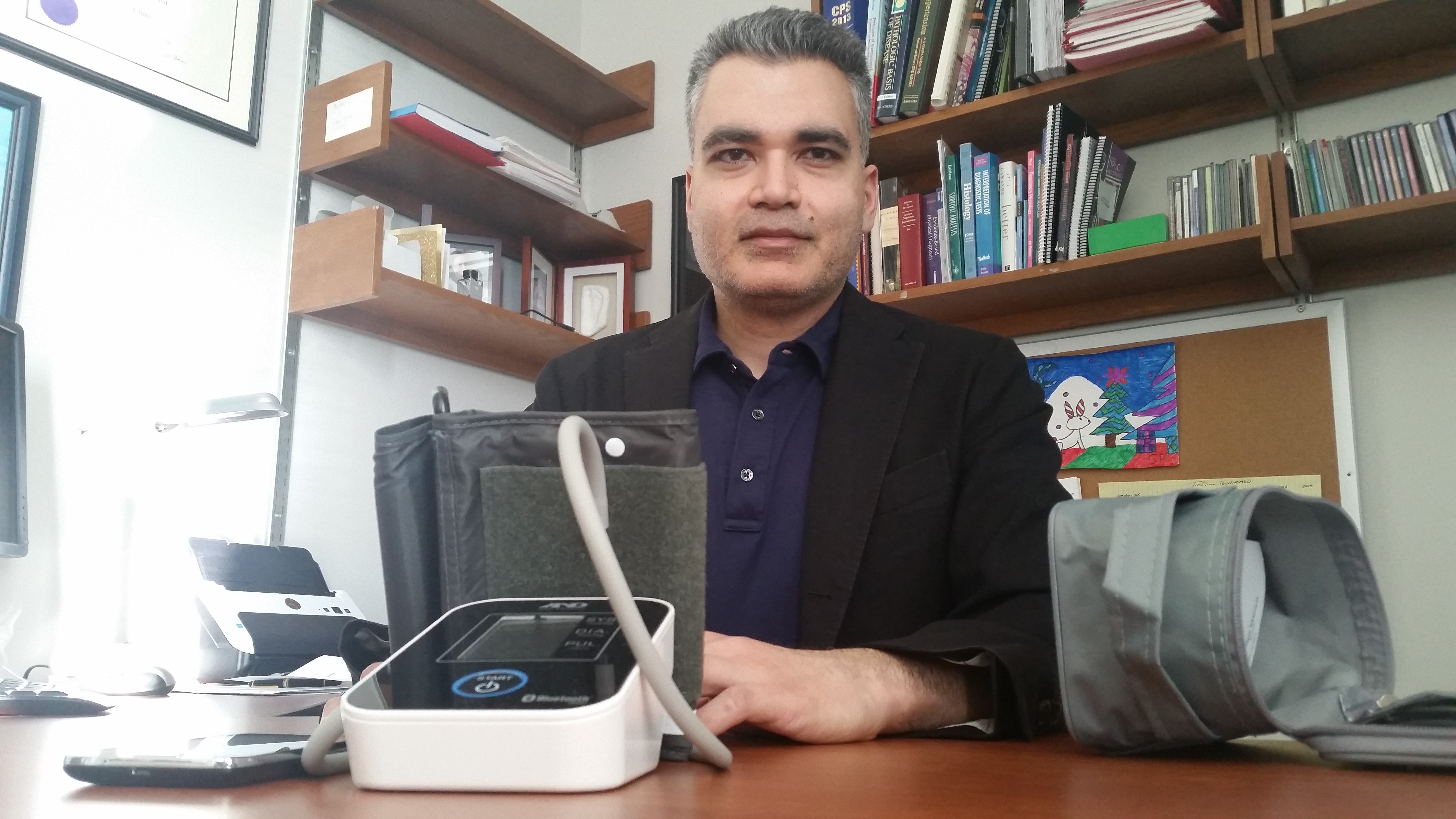
Raj Padwal of the Faculty of Medicine & Dentistry's Division of General Internal Medicine shows equipment to be used for home-based blood pressure monitoring.
The Canadian Institutes of Health Research (CIHR) has announced $750,000 in funding over four years to help support the research of Raj Padwal, a professor of medicine in the Faculty of Medicine & Dentistry's Division of General Internal Medicine. The grant, given through CIHR's e-Health Innovation Partnership Program (eHIPP), will allow Padwal to study the benefits of home-based monitoring of senior patients with diabetes and hypertension. The research is also supported by a contributing Alberta Innovates - Health Solutions grant of $187,500.
Padwal and colleagues' research will monitor the blood pressure of seniors residing in supportive living at Greater Edmonton Foundation and Rosedale homes in Edmonton, with the hope to improve co-ordination of their care while determining the cost-effectiveness of home-based telemonitoring systems. This study comes following new guidelines in Canada recommending that patients measure their blood pressure away from their doctor's office.
"We know from other studies that a patient's blood pressure reading taken at their doctor's office is not very accurate," Padwal explains. "That's based on many factors including 'white coat syndrome.' Patients get nervous when they go to their physician's office, or the reading is rushed and it is often falsely high. We hope to find that if we educate patients to take their own blood pressure at home and have the results telemonitored, the results will be more accurate-and more importantly, we can find out if we're providing them with the most appropriate care."
The study will involve a partnership of the University of Alberta (Faculty of Medicine & Dentistry) and University of Calgary (Cumming School of Medicine and Faculty of Science) with Alberta-based Pharmacare and Ontario-based Telemed. Patients will use Bluetooth-enabled monitors to check their blood pressure up to four times a day for one week. The results will be transmitted to a secure health portal to be reviewed by a Pharmacare pharmacist case manager, who will use the average reading to adjust medication if necessary.
"Lowering and controlling high blood pressure can reduce the risks of some of the most common medical problems in our society-heart disease, heart failure, stroke and kidney disease. This study will help show how effectively we can bring high blood pressure under control."
Equally important, this research will indicate how often patients' blood pressure drops too low.
"Sometimes people get put on medications when they are in their fifties and sixties, and their need for it is never reassessed," says Padwal. "Then, as they age, they may start to develop side-effects including low blood pressure and even falls. We're trying to see how often this happens and determine if it's better managed with ongoing monitoring."
Padwal's is one of 22 projects funded by eHIPP, CIHR and its partners. All have an emphasis on providing mobile and home-based solutions that encourage patients to be more involved in their health status. The added benefit to these projects is the confidence that comes with patients taking control of their own care.
"Canada has no shortage of innovative health-care thinkers, top-notch health researchers or vibrant entrepreneurs," says CIHR president Alain Beaudet. "Through eHIPP, these great minds are coming together to deliver creative eHealth solutions for some of our country's most pressing health-care needs. I am particularly proud of the ways in which these projects put patients first, often empowering them to be partners in their own care."
The telemonitoring research will be conducted over the next four years, and Padwal is confident that, if the merits of this alternative are proven, transitioning patients to using home blood pressure values instead of office readings will eventually occur. Telemed has been conducting similar work over the past 10 years, most notably by transmitting EKG results to physicians and to Netcare, the provincewide electronic health record.
"The biggest challenge is to find out if people will accept the new system," Padwal explains. "Do they find the at-home monitoring useful? Is the system going to work? Will there be bugs and can we work through them? Will providers find it useful? What about caregivers? That's why this study is so important."
The researcher believes that, if telemonitoring proves to be cost-effective and acceptable, it will lead to benefits for all parties and make life easier for patients that have difficulty getting to the clinic.
"Ultimately, the results may support paradigm shift in care delivery. We already know that home readings are more accurate than clinic readings, so why do we make patients come to the clinic for a hypertension followup visit?" Padwal asks. "If you're a telemonitored patient and all I need to do is review your readings using the web portal or my electronic medical records, and give you a quick call to find out how you are feeling, we can then make a plan together. If a medication adjustment is needed, I can just call the pharmacy. On top of that, my clinic will then have more time to work with other patients with more complex issues. Senior patients and patients with mobility issues won't have to find a way to get to the clinic, while others won't have to take a whole morning off work to accommodate the appointment.
"Of course, we will need to consider new reimbursement strategies so that providers are paid to deliver care this way. But if it's better for everyone involved, this is the way I see care delivery going."